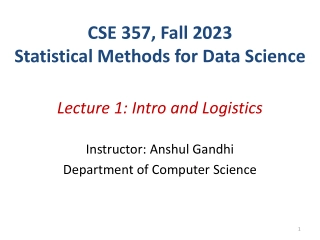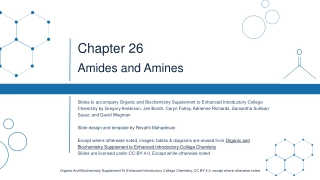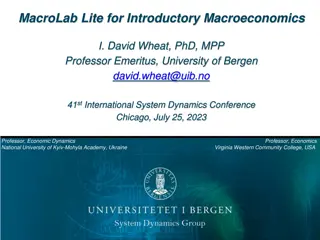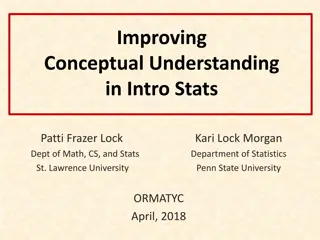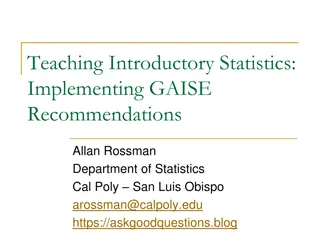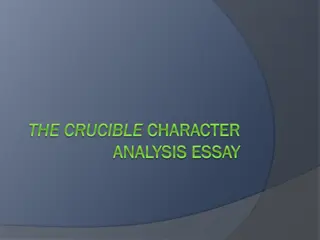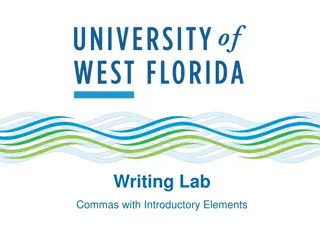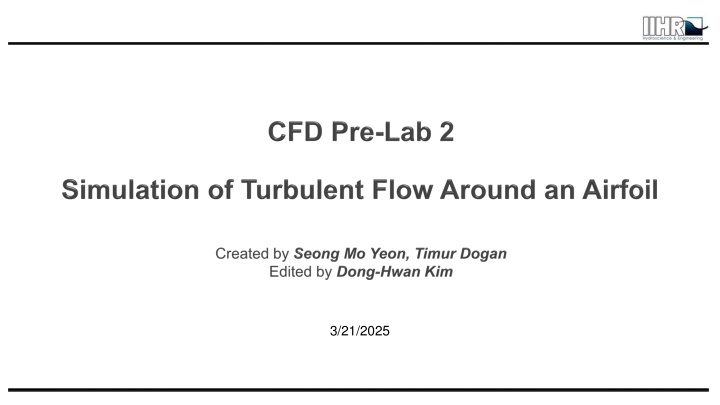
Simulation and Analysis of Airfoil Flow for ENGR 2510 Mechanics of Fluids
Conduct a simulation of flow around an airfoil for the ENGR 2510 Mechanics of Fluids course. Explore concepts of boundary layers, flow separation, and compare Computational Fluid Dynamics (CFD) results with Experimental Fluid Dynamics (EFD). Learn about lift and drag forces, viscous flow, and the procedure for simulating airfoil flow using ANSYS software.
Download Presentation

Please find below an Image/Link to download the presentation.
The content on the website is provided AS IS for your information and personal use only. It may not be sold, licensed, or shared on other websites without obtaining consent from the author. If you encounter any issues during the download, it is possible that the publisher has removed the file from their server.
You are allowed to download the files provided on this website for personal or commercial use, subject to the condition that they are used lawfully. All files are the property of their respective owners.
The content on the website is provided AS IS for your information and personal use only. It may not be sold, licensed, or shared on other websites without obtaining consent from the author.
E N D
Presentation Transcript
1. Overview of Flow Around Airfoil 2. CFD Process 3. Geometry 4. Mesh 5. Physics 6. Results 3/21/2025 2 ENGR:2510 Mechanics of Fluids and Transport Processes 2016F
Simulation of the flow around the airfoil will be conducted for this lab Computational fluid dynamics (CFD) results for drag and lift coefficients, coefficient of pressure around the airfoil will be compared to experimental fluid dynamics (EFD) This lab will cover concept of boundary layer and flow separation Flow visualization around airfoil (starts at 5:34) 3/21/2025 3 ENGR:2510 Mechanics of Fluids and Transport Processes 2016F
Boundary Layer Defined by Ludwig Prandtl Generated by viscosity near wall Cause of lift and drag forces Inviscid vs. viscous flow Flow separation Note: Refer to Chapter 9 of your book for more details Flow visualization of boundary layer (Start at 3:21) 3/21/2025 4 ENGR:2510 Mechanics of Fluids and Transport Processes 2016F
The overall procedure for simulation of flow around airfoil is shown on chart below Although we will be making the mesh before we define the physics you have to know the physics to design appropriate mesh. Physics Geometry Results Mesh Solution Airfoil (ANSYS Design Modeler) General (ANSYS Fluent - Setup) Solution Methods (ANSYS Fluent - Solution) Structured (ANSYS Mesh) Plots (ANSYS Fluent- Results) Model (ANSYS Fluent - Setup) C-Domain (ANSYS Design Modeler) Graphics and Animations (ANSYS Fluent- Results) Non-uniform (ANSYS Mesh) Boundary Conditions (ANSYS Fluent - Setup) Solution Controls (ANSYS Fluent - Solution) O-Domain (ANSYS Design Modeler) Monitors (ANSYS Fluent - Solution) Reference Values (ANSYS Fluent - Setup) Solution Initialization (ANSYS Fluent - Solution) Turbulent Solution Initialization (ANSYS Fluent - Solution) Run Calculation (ANSYS Fluent - Solution) 3/21/2025 5 ENGR:2510 Mechanics of Fluids and Transport Processes 2016F
Import Clark-Y airfoil geometry Split O-type domain into four pieces Parameter Chord length, c Diameter of domain, Rc Angle of attack, Value 0.3048 m 12.0 m 0, 16 3/21/2025 6 ENGR:2510 Mechanics of Fluids and Transport Processes 2016F
Fine mesh at the boundary layer region to resolve large velocity gradients 3/21/2025 7 ENGR:2510 Mechanics of Fluids and Transport Processes 2016F
Turbulent flow Viscous & Inviscid models Air properties (Need to be extracted from the EFD) Boundary Conditions (BC) (Need to be extracted from the EFD) No-slip (airfoil surface): velocities and pressure gradient are zero (??= 0,??= 0, Inlet velocity: uniform constant velocity (??= ??? ????? ???????? [?/?],??= 0,?? Outlet: (gauge) pressure is imposed to the boundary (??? ?? ??= 0) ??= 0) Wall No slip BC ??= 0, ??? ??= 0,? =??????=0) (where n is the normal vector) Inlet Velocity inlet BC Outlet Pressure outlet BC 3/21/2025 8 ENGR:2510 Mechanics of Fluids and Transport Processes 2016F
If you have problems with solution convergence reduce Under-Relaxation Factors. This issue is more likely to occur for large angle of attack cases. Also you may need to increase the number of iterations 3/21/2025 9 ENGR:2510 Mechanics of Fluids and Transport Processes 2016F
Benchmark Data Experimental-2013 Experimental-2010 experimental-2012 CFD Benchmark Data Experimental-2013 Experimental-2012 experimental-2010 CFD 1.5 1 1 0.5 0.5 Cp 0 0 0 20 40 60 80 100 0 20 40 60 80 100 Cp -0.5 -0.5 -1 -1 -1.5 -1.5 -2 X/Chord -2 X/Chord -2.5 Coefficent of Pressure (Cp ) Distribution at 16 AOA Coefficent of Pressure (Cp ) Distribution at 0 AOA 3/21/2025 10 ENGR:2510 Mechanics of Fluids and Transport Processes 2016F
Pressure distribution around airfoil Velocity vectors near wall and boundary layer development Stream lines around airfoil 3/21/2025 11 ENGR:2510 Mechanics of Fluids and Transport Processes 2016F
Deadline for the CFD Lab 2 report is two weeks after from your CFD lab 2 (same as CFD Prelab1 & Lab1) Pre-lab 2 questions will be graded separately, so it doesn t need to be attached to the report Bring EFD Lab3 Data Reduction Sheet for CFD Lab2, so that you can simulate AOA=16 degree case Use the Lab drop-box when turning in your lab reports Come to the office hours for any help 3/21/2025 12 ENGR:2510 Mechanics of Fluids and Transport Processes 2016F


